ISMRT Poster Presentations
ISMRT Research Posters
ISMRM & ISMRT Annual Meeting & Exhibition • 04-09 May 2024 • Singapore

| 17:00 |
5146.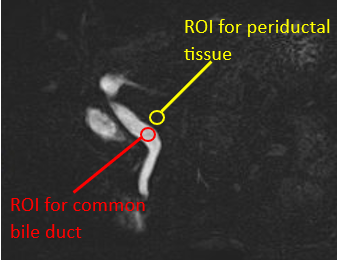 |
3DMRCP Quantitative Image Quality: A Comparison Between
CS-SENSE And SENSE And Its Acquisition Time
Chee Chian Teo1
1Diagnostic Radiology, Tan Tock Seng Hospital, Singapore, Singapore Keywords: Motivation: Upgrading of MR scanner with compressed sensing (CS) could reduce acquisition time. Image quality of 3DMRCP with CS, however, need to be assessed quantitatively to ensure its standard despite of acceleration. Goal(s): We aimed to prove that 3DMRCP with CS can be employed in clinical practice with comparable quantitative image quality to SENSE and with shorter acquisition time. Approach: Quantitative image quality (signal intensity, noise, SNR and CNR) of 3DMRCP with CS and SENSE of the same subject that acquired at two different timepoints were compared retrospectively. Results: 3DMRCP with CS have maintained the quantitative image quality and has a shorter scan duration. Impact: 3DMRCP with CS only not can achieve higher spatial resolution but also with a shorter acquisition time while maintaining its quantitative image quality. Therefore, 3DMRCP with CS is recommended to be adopted in daily clinical practice. |
| 17:00 |
5147.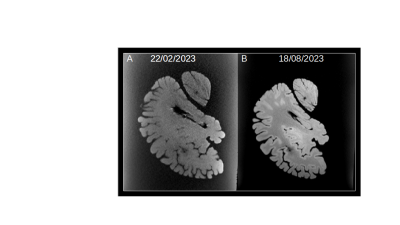 |
Challenges in setting up an ex-vivo brain MRI protocol
Liana Guerra Sanches1,2,
Roqaie Moqadam 1,
Elena Drobotea1,
Danae Dumouchel1,
Yashar Zeighami1,2,
Mallar Chakravarty1,2,
and Mahsa Dadar1,2
1Brain Imaging Centre, Douglas Research Centre, Douglas Research Centre, Montreal, QC, Canada, 2Department of Psychiatry, McGill University, Montreal, QC, Canada Keywords:
Motivation: Help MRI operators and other
professionals who plan to acquire ex-vivo brain MRI Goal(s): What are the challenges in setting up an ex-vivo brain MRI protocol? Approach: This abstract shows the challenges faced during the establishment of an ex-vivo brain MRI protocol in a 3-tesla scanner. Results: We organized 2 categories of challenges our team faced: Dealing with motion and with contrast. We have detailed and illustrated each challenge and provided the learning points we thought were important. Impact: Scanning of ex-vivo specimens poses challenges. The literature doesn't present the problems faced in preparation phase. We provide realistic view of these challenges from the perspective of MRI scientists, to help other teams approach this problem with the proper orientation. |
| 17:00 |
5148.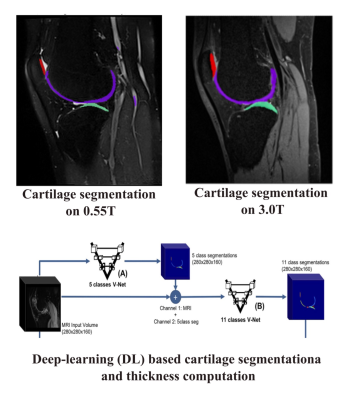 |
Comparative Assessment of Deep Learning (DL) for Femoral
Cartilage Thickness in Healthy Controls: A Study on 0.55T vs
3.0T MRI Scanners.
Vahid Ravanfar1,
Emma Bahroos1,
Rupsa Bhattacharjee1,
and Sharmila Majumdar1
1Radiology and Biomedical Imaging, University of California San Francisco, San Francisco, CA, United States Keywords:
Motivation: Prior knee osteoarthritis studies
favor high-field (3.0T) over mid-field (0.55T) MRI.
Motivation is explore sustainable, economical,
low-footprint 0.55T alternative. Goal(s): To address the research gap, this study aims to compare cartilage thickness measurements in healthy controls between 0.55T and 3.0T MRI scanners, shedding light on the viability of mid-field imaging for assessing this vital biomarker. Approach: Employing a cross-sectional design, this research utilizes both 0.55T and 3.0T scanners to gather comparative data on cartilage thickness in healthy subjects.
Results: Anticipated findings will contribute
insights into the potential of mid-field MRI for
accurate cartilage assessment, informing future imaging
practices in knee osteoarthritis research. Impact: This project's focus on mid-field MRI scanners may revolutionize knee osteoarthritis research, providing a cost-effective alternative, broadening accessibility, and potentially improving early diagnosis and treatment outcomes for patients. |
| 17:00 |
5149.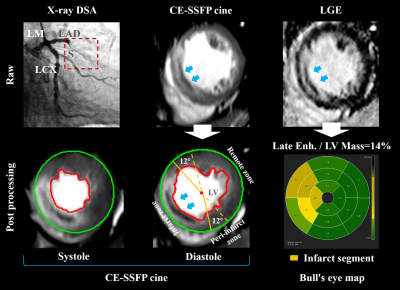 |
Left Ventricular Dyssynchrony in Anterior ST-Elevation
Myocardial Infarction
Zheng Sun1,
Jie Lu1,
and Kuncheng Li1
1Radiology and Nuclear Medicine, Capital Medical University XuanWu Hospital, Beiing, China Motivation: Since the septal function is critical to the global LV function and prognosis, we suggest further refining global and segmental septal viability analysis. Goal(s): This study aimed to characterize myocardial strain alterations by CMR-feature tracking for patients with anterior STEMI. Approach: The size of the infarction and the extent of injury, to investigate if any changes in septal function would affect the balance of strain. Results: The infarcted septum swings in a bimodal mode, and myocardial injury reduces the radial strain contractility. A more than 75% transmural degree was the septal strain-contraction reserve cut-off point. Impact: The combination of CMR-LGE and strain puts forward an efficient risk stratification. This technique can help clinicians make accurate decisions, especially for patients with LBBB, avoiding the LV lead placed in the infarcted zone. |
| 17:00 |
5150.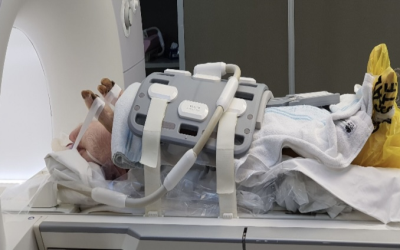 |
Impact of radiographer-led change on cMRI protocol in
porcine stem cell study
Naeim Nick Sanaei1,
Anthea Lok Lon Min1,
Dinesh Selvakumar1,
Tejas Deshmukh1,
Arthur Escalona1,
Dennis Wong1,
Vien Mouangvong1,
Brendan Evans2,
Pathan Faraz3,
James Chong1,
and Sheryl Foster1
1Westmead Hospital, Sydney, Australia, 2Sectra, Sydney, Australia, 3Sydney University, Sydney, Australia Keywords: Motivation: Knowledge that a suboptimal acquisition protocol was being implemented in a large and expensive animal research study. Goal(s): Demonstration of improved image quality in a porcine study investigating remuscularisation effects of stem cell treatment in diseased and injured hearts. Approach: Implementation of a FB protocol in tandem with a BH protocol in a subset of porcine subjects (n=38) who had undergone percutaneous induction of myocardial infarction.
Results: Superior image quality and greater
reproducibility of BH techniques with shorter scan
times results in the need for remarkably smaller sample
sizes to show clinically significant treatment effects. Impact: MRI radiographers are an untapped resource in many sites performing research. This study demonstrated the impact of radiographer expertise in protocol development and subsequent improvement in research data quality and outcomes in a large and expensive animal study. |
| 17:00 |
5151.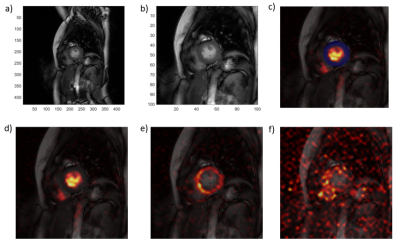 |
Real-time hyperpolarized 13C-pyruvate CMRI imaging pipeline
for monitoring of cardiotoxicity
Fatemeh Khashami1,
Ivan E Dimitrov2,3,
Maximilian Fuetterer4,
Sebastian Kozerke4,
Emily Buchanan3,
Crystal E Harrison3,
Mai Huynh3,
Aneela Afzal1,
Jae Mo Park3,
Zoltan Kovacs3,
Craig R. Malloy3,5,
Anke Henning3,
and Vlad G. Zaha1,3,6
1Department of Internal Medicine, University of Texas Southwestern Medical Center, Dallas, TX, United States, 2Philips Healthcare, Gainesville, FL, United States, 3Advanced Imaging Research Center, University of Texas Southwestern Medical Center, Dallas, TX, United States, 4ETH Zurich, Institute for Biomedical Engineering, Zürich, Swaziland, 5Dallas VA Medical Center, Dallas, TX, United States, 6Harold C. Simmons Comprehensive Cancer Center, Dallas, TX, United States Motivation: Real-time imaging protocol based on hyperpolarized 13C pyruvate to probe metabolic changes in patients undergoing standard-of-care chemotherapy for breast cancer, with cardiotoxic potential. Goal(s): An imaging protocol that results in high-quality reproducible B0 heart shimming. To implement an echo-shifted mDIXON acquisition with spatial-spectral excitation to detect pyruvate and its major byproducts. A processing pipeline for reconstruction of metabolic images. Approach: Single-shot EPI acquisitions with shifted echo times (n=6) were acquired following a SpSp excitation, as to generate signal for mDIXON / IDEAL reconstructed images of these metabolites. Results: We have established a real-time 13C-hyperpolarization and imaging protocol and reconstruction pipeline Impact: Noninvasive real-time metabolic imaging using hyperpolarized 13C may aid clinical evaluation of possible cardiac toxicity for breast cancer patients |
| 17:00 |
5152. |
A motion aware DNN model with edge focus loss and quality
control for short-axis left ventricle segmentation of cine
MR sequences
Zheng Sun1,2 and
Jie Lu1
1Radiology and Nuclear Medicine, Capital Medical University XuanWu Hospital, Beiing, China, 2School of Biomedical Engineering, Capital Medical University, Beijing, China Motivation: We propose a motion aware DNN model for cardiac sequence segmentation. Goal(s): We construct an in-house dataset which has three advantages: segmentation annotations covering the cardiac cycle; comprehensive annotations, including the annotations of interventricular groove structure; fine annotations of endocardium. Approach: We propose an edge focus loss to make the segmented boundaries be consistent with the local gradient of the input images and propose a quality control method based on Image Moments to filter abnormal predictions. Results: The experimental results highlight the accuracy of the proposed model, and the fine segmentation results could be used to estimate accurate clinical indicators for clinical diagnosis. Impact: In experiments, we compare the proposed model with 12 state-of-the-art segmentation models, and our model have obtained the highest accuracy for the segmentation and the highest PCC on the 17-segment model. |
| 17:00 | 5153. |
Dynamic Monitoring of the Treatment Effect of E. coli and
PD-1 Inhibitor in Mouse Glioblastoma: using High-Field
Animal Multimodal MRI
Guochen Li1,
Guangrong Zheng2,
Tengfei Ke3,
and Chengde Liao2
1Yan'an Hospital Affiliated to Kunming Medical University, Kunming, China, China, 2Yan'an Hospital Affiliated to Kunming Medical University, Kunming, China, 3The Third Affiliated Hospital of Kunming Medical University, Kunming, China Motivation: Immunotherapy for glioma has demonstrated promising potential in preclinical studies. However, the dynamic assessment of its effectiveness in the brain presents a significant challenge. Goal(s): To continuously monitor the effectiveness of PD-1 inhibitors when combined with bioengineered Escherichia coli in the treatment of GBM in mouse model, utilizing high-field animal MRI technology. Approach: Throughout the treatment of glioma-bearing mouse with E. coli and/or PD-1 inhibitors, we employed multimodal MRI and immunofluorescence techniques to routinely observe changes within the tumor microenvironment. Results: The high-field MRI technology utilized for monitoring the tumor microenvironment revealed positive outcomes for the combination therapy, consistent with our laboratory findings. Impact: Our research suggests that the fusion of bioengineered Escherichia coli and PD-1 inhibitors may herald a groundbreaking development in GBM immunotherapy, with high-field MRI technology serving as a potent tool for the real-time evaluation of this combination therapy's efficacy. |
| 17:00 |
5154.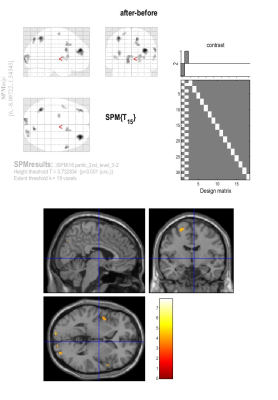 |
Peek into an enduring language: An exploration of speed
reading through the lens of neuroimaging
Thishuli Walpola1,
Seina Yoshida1,
and Atsushi Senoo1
1Department of Radiological Sciences, Graduate School of Human Health Sciences, Tokyo Metropolitan University, Arakawa, Japan Motivation: Despite the growing interest in fast reading, which is a cutting-edge research area, researchers have not yet explored its potential in a lesser-known language. Goal(s): Our goal was to explore the neural activation during the fast reading of ‘Sinhala’ letters. Approach: Healthy Sinhalese participants were subjected to functional MRI (3T) along with a fast-reading training session to analyze pre- and post-fast-reading neural impacts. Results: Correlation analysis showed a significant increase in the activity of the right middle frontal gyrus in rapid reading than in ordinary reading (PFEW-corr(p<0.05)). Impact: The increment of brain activation noticed in the fast-reading trained group suggests the significance of evaluating neural correlates unique to a language. This finding may aid in the development of effective fast-learning methods and improve approaches to second-language learning. |
| 17:00 |
5155.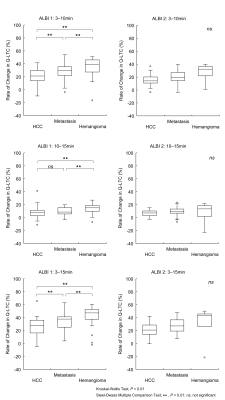 |
Proposal for a New Liver Tumor Classification Method in MRI
Yasuo Takatsu1,2,
Masafumi Nakamura2,3,
Tosiaki Miyati2,
and Satoshi Kobayashi2
1Fujita Health University: Fujita Ika Daigaku, Toyoake, Japan, 2Division of Health Sciences, Graduate School of Medical Sciences, Kanazawa University, Kanazawa, Japan, 3Tokushima Bunri University, Sanuki, Japan Motivation: Liver tumors could be classified with the help of machine learning or other methods based solely on changes in Gd-EOB-DTPA uptake over time. Goal(s): To evaluate the possibility of classifying liver tumor types using changes in liver and tumor contrast (Q-LTC) over time. Approach: Liver tumors (HCC, metastasis, and hemangiomas) were classified. The rate of change in Q-LTC were calculated using images obtained at 3, 10, and 15 min after Gd-EOB-DTPA administration. Results: The rate of change in Q-LTC over time tended to be higher in HCC, metastasis, and hemangioma, in that order; therefore, its potential use in liver tumor classification. Impact: To reduce the burden on patients caused by extended examination time, we performed liver tumors classification using simple liver and tumor contrast based on the liver function, during routine clinical studies without requiring additional specialized imaging. |
| 17:00 | 5156. |
A prospective multi-model study on comparative analysis of
MRI with 18F-FAPI or 18F-FDG PET/CT to detect intestinal
fibrosis in Crohn’s disease
Zhoulei Li1,
Yangdi Wang1,
Ruonan Zhang1,
Siyun Huang1,
Chen Zhao2,
Shi-Ting Feng1,
and Xuehua Li1
1Radiology Department, The First Affiliated Hospital of Sun Yat-sen University, Guangzhou, Guangdong, China, 2MR Research Collaboration Team, Shanghai, China Motivation: The accurate diagnosis of intestinal fibrosis is very important for CD management. Goal(s): The characterization of intestinal fibrosis by using non-invasive imaging techniques on intestinal lesions with various fibrosis and inflammation, to explore the optimal clinical applications for commonly used imaging techniques in clinical practice for fibrotic diagnosis, providing valuable insights for clinical decision-making. Approach: PET/CT and MTI were performed on animal and patient to investigate their efficiency on analyzation of intestinal fibrosis. Results: The diagnostic effect of 18F-FAPI PET/CT in detecting CD fibrosis surpasses that of 18F-FDG PET/CT, while comparable to MTI, and offers great potential in early detection of intestinal fibrosis. Impact: MTI is the most accurate technique for detecting intestinal fibrosis. 18F-FAPI PET/CT represents an optimal imaging technique currently, in terms of early fibrosis detection. However, its interpretation with fibrosis still requires caution due to the slight susceptibility to co-existing inflammation. |
| 17:00 |
5157.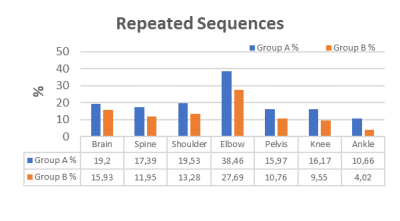 |
Value Assessment of Orthogonal Phase Encoding Reduction
Artifacts, O.P.E.R.A.
Andrea Dell'Orso1,
Vincenzo Positano2,
Francesco d'Errico3,
Giovanni Arisi4,
Benedetta Banchi5,
Aldo Taddei6,
and Claudio De Felice7
1Radiology, Azienda USL Toscana Centro, Empoli, Florence, Italy, 2FTGM Fondazione Toscana Gabriele Monasterio, Pisa, Italy, 3Biomedical Engineering, University of Pisa, Pisa, Italy, 4Bluesotware, Poggibonsi, Siena, Italy, 5Radiology, Ausl Le Scotte, Siena, Siena, Italy, 6Radiology, Area Vasta Toscana Sud-EST, Siena, Siena, Italy, 7Neonatal Intense Care Unit, AUSL Le Scotte,Siena, Siena, Italy Keywords: Motivation: Artifacts are common in MR and reduce the image quality, and led to a degradation of the radiographer's work. We developed a retrospective method, Orthogonal Phase Encoding Reduction Artifacts (OPERA) which works on DICOM images. Goal(s): To test the value assessment of OPERA on several anatomic regions in a Clinical Study on a Public General Hospital.
Approach: A total of 604 MR exams were acquired
on 585 patients by using an 1.5T scanner. Results: OPERA algorithm reduced the repeated sequences of 5.9% and the additional sequences of 2.17%.
Impact: Opera requires no hardware modifications.
OPERA is a post-processed software and works on DICOM,
so it is applicable on any type of MRI scanner. |
| 17:00 |
5158.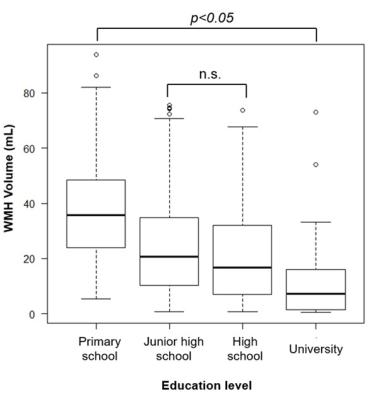 |
Correlation between quantitative software analysis-based
white matter hyperintensity volume on FLAIR image and
cognitive impairment
Ryuya Okawa1,2,
Norio Hayashi3,
Go Yasui1,
Ban Mihara4,
Tetsuhiko Takahashi3,
and Ryo Atarashi2
1Department of diagnostic imaging, Institute of Brain and Blood Vessels Mihara Memorial Hospital, Isesaki, Japan, 2Graduate School of Radiological Technology, Gunma Prefectural College of Health Sciences, Maebashi, Japan, 3Department of Radiological Technology, Gunma Prefectural College of Health Sciences, Maebashi, Japan, 4Department of Neurology, Institute of Brain and Blood Vessels Mihara Memorial Hospital, Isesaki, Japan Motivation: Acquiring new knowledge about the clinical significance of white matter hyperintensity (WMH) is important. Goal(s): This study aimed to investigate the relationship between WMH volume and cognitive impairment. Approach: Patients information (sex, age, education level), neuropsychological examinations (Mini-Mental State Examination and the Japanese version of Montreal Cognitive Assessment), and FLAIR images were retrospectively examined as clinical data. WMH volume was analyzed from FLAIR images with fully automated analysis software. The relationship between WMH volume and clinical data was investigated. Results: WMH volume significantly differed according to education level, and that WMH volume was associated with neuropsychological examinations. Impact: The white matter hyperintensity volume obtained from fluid-attenuated inversion recovery images using a fully automated white matter signal analysis software could provide important clinical information about cognitive impairment in patients. |
| 17:00 |
5159.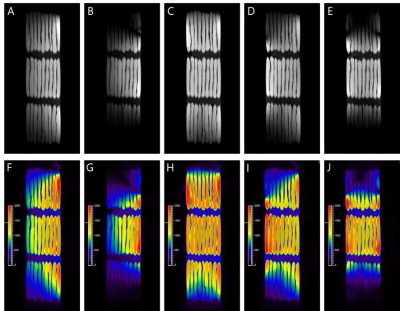 |
Study on 2 Channel Application of Microscopy Coil Using
Self-made Phantom
Han Byul Chung1,
Young Mi Kim1,
Eun Hee Seo1,
and Chang Min Dae1
1Radiology, Seoul National University Bundang Hospital, Seongnam-si, Korea, Republic of Motivation: Microscopy coil has high spatial resolution and SNR, but it has a limited effective Signal Intensity(SI) range. Goal(s): This study suggests a method to improve SI & effective SI range by various combinations of Microscopy Coil. Approach: We made a MRI Marker Phantom and analyzed SI using Microscopy Coil with 1channel (23mm, 47mm), 2channel (23+47mm, 23+23mm, 47+47mm). We measured effective SI range and SI. Results: In the results, SI of 2channel was higher than that of 1channel in all 12 ROI. Furthermore, change of changing of sense factor showed no significant change. Effective SI range was 47+47mm, 23+47mm, 47mm, 23+23mm, 23mm coil respectively. Impact: Various combinations of Microscopy 2channel Coil had advantage of increasing Signal Intensity(SI) and effective SI range compared to 1channel. Also use of sense factor in 2channel can reduce scan duration without SI change for patients who have difficulty in cooperating. |
| 17:00 |
5160.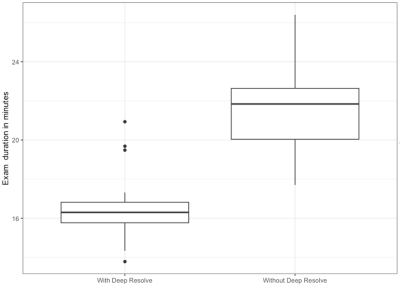 |
Impact of Deep Resolve Sharp & Gain AI software on patient
throughput and image quality at 3.0 Tesla: A preliminary
study in knee.
Theodore Joseph Kryzer1,
Houchun Harry Hu2,
Hannah Spears3,
and Alex N Merkle2
1Radiology, UCHealth, Highlands Ranch, CO, United States, 2Radiology, University of Colorado School of Medicine, Aurora, CO, United States, 3Colorado School of Public Health, Aurora, CO, United States Keywords: Motivation: To quantify the impact of Deep Resolve Sharp and Gain (DRSG) Artificial Intelligence (AI) software on patient throughput and image quality of knee MRI exams at 3.0 Tesla. Goal(s): To study the clinical the impact of DRSG on image quality and examination time. Approach: Thirty patients underwent examinations without or with DRSG enabled. An attending musculoskeletal radiologist blindly reviewed exams and the quality of structures was assessed in routine diagnostic planes. Exam times were recorded. Results: Knee structures showed no statistical difference in image quality. Meanwhile, a statistically significant reduction in mean exam time was observed with DRSG-enabled protocols of 24% (p<0.001). Impact: Siemens Healthineers Deep Resolve Sharp & Gain is a clinically useful tool to significantly reduce MR knee exams times without compromising image quality at 3.0 Tesla. |
| 17:00 |
5161.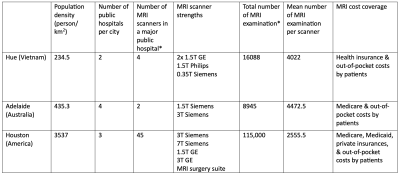 |
A Multiregional Study of MRI Services Between Huế (Vietnam),
Adelaide (Australia), and Houston (America)
Haley Vu1,
Vi Phan2,
and Ngoc Thanh Hoang3
1University of South Australia & South Australia Medical Imaging, Adelaide, Australia, 2Houston Methodist Hospital, Houston, TX, United States, 3University of Medicine and Pharmacy & Hue University, Hue, Vietnam Keywords: Motivation: Understanding variances in MRI services between different countries serves as a foundation for enhancing global MRI services, fostering the attainment of equitable and high-quality healthcare services globally. Goal(s): What are differences in MRI services among Huế, Adelaide, and Houston, and what are the implications for global MRI service enhancement? Approach: Data on various dimensions of MRI services was collected to investigate differences and similarities in technological infrastructure, image acquisition, service delivery, cost structures, professional expertise, and prevalent policies surrounding MRI services. Results: The investigation revealed substantial discrepancies between cities; however, there are similarities in service delivery and training processes. Impact: The study lays as a groundwork for the enhancement of global MRI services by identifying MRI service disparities among different regions, with the ultimate goal of fostering equitable and high-quality healthcare services globally. |
| 17:00 |
5162.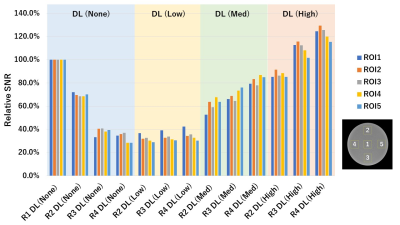 |
Unrolled Variational Networks and Super Resolution in
Clinical MRI at 3 Tesla: An Evaluation of Noise
Characteristics, Contrast, and Sharpness
Ryosuke Nasada1,
Kenji Ugusa1,
and Kumiko Ando2
1Radiological Technology, Kobe City Medical Center General Hospital, Kobe, Japan, 2Department of Diagnostic Radiology, Kobe City Medical Center General Hospital, Kobe, Japan Keywords: Motivation: Deep Learning based reconstruction methods, specifically Unrolled Variational Networks (UVN), have been proposed to enhance MRI image quality at high reduction factors. However, physical image characteristics have not been fully evaluated. Goal(s): This study evaluated the noise, contrast characteristics, and sharpness in images reconstructed using UVN. Approach: Various phantoms were utilized for evaluation, assessing SNR, Noise Power Spectrum, Contrast Ratio, and Point Spread Function. Results: With an increase in the reduction factor, the SNR improved, but both low-frequency and high-frequency noise increased. Despite a slight decrease in the contrast ratio with the increase in reduction factor, DL application notably enhanced image sharpness. Impact: Our study investigates the application of Unrolled Variational Networks in MRI systems. The potential improvement in image quality could lead to more accurate diagnoses, changing the way clinicians approach MRI imaging and prompting further research in medical imaging. |
| 17:00 |
5163.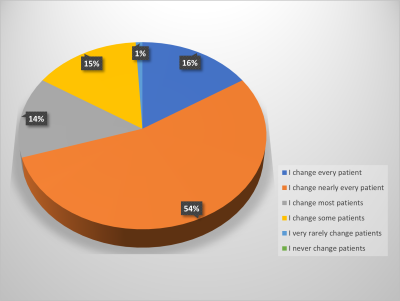 |
A study of current clinical practice: Do MRI technologists
in New Zealand always ask patients to change before
examinations?
Adrienne Jane Young1 and
Katherine Eunwoo Song1
1Faculty of Medical and Health Sciences, University of Auckland, Auckland, New Zealand Keywords: Motivation: Failure to change MRI patients into facility-supplied attire has led to burns and projectile injuries, and MRI technologists are responsible for ensuring appropriate patient preparation. Goal(s): To investigate the current practice of changing patients into gowns by New Zealand (NZ) MRI technologists and examine factors that influence decision-making. Approach: An online questionnaire was distributed to MRI technologists and trainees currently working in NZ. Results: Most technologists change all or most patients, but emerging practices of removing patient underwear and changing patient companions are less well-adhered to. Workplace policies are recommended as they influence technologists’ practice, and management support is needed to implement these. Impact: Failure to change MRI patients into facility-supplied attire has led to numerous avoidable injuries, yet a survey of MRI technologists in New Zealand has revealed that clinical practice varies. Workplace policies influence practice and are recommended to maximise patient safety. |
| 17:00 | 5164. |
A novel paramagnetic probe for in-vivo MRI imaging of
cannabinoid-1 receptor in the mouse brain
Qi Ouyang1,
Fei Zhao1,
and Garth Thompson2
1ShanghaiTech University, Shanghai, China, 2ShanghaiTech University, Shanghai, United Kingdom Motivation: Localization of Cannabinoid type I receptor (CB1) across the whole brain with high temporal and spatial resolution would help a fundamental understanding of this receptor. Goal(s): We sought to develop an in vivo MRI probe suitable for the cannabinoid system. Approach: By chemically conjugating Rimonabantacid to the gadolinium chelate, we sought to create a novel paramagnetic probe TC1648·Gd. Introduction of this drug into mouse brains furthermore permits MRI-based measurement. Results: Comparing the PET results with the TC1648.Gd, the high expression of CB1 in the hippocampus and the poor expression in the hypothalamus are highly consistent. TC1648.Gd enable imaging-based assessment of distribution of CB1. Impact: The reagent is straightforward to produce and apply, and could immediately be used in a range of preclinical biomedical contexts. In future work, the idea of conjugating paramagnetic moieties to neuromodulatory agents could be extended to create additional MRI-detectable probes. |
| 17:00 |
5165. |
Multi-echo SWI at 0.5T: Acquisition and AI-Reconstruction
Sajith Rajamani1,
Florintina C1,
Rajagopalan Sundaresan1,
Ashok Kumar P Reddy1,
Arjun Narula2,
Mayuri Limbachiya2,
Suresh Joel1,
and Ramesh Venkatesan1
1GE HealthCare, Bangalore, India, 2Narula Diagnostics, Rohtak, India Motivation: To explore the feasibility of multi-echo susceptibility weighted imaging at 0.5T as lower field strength MRI scanners are cost effective. Goal(s): Assess the effectiveness of swi at lower field strength as it is one of the important sequences in Brain MRI Approach: This study involves acquisition of 3D multi-echo gradient echo sequence to generate SWI with combination of protocol optimization specifically for 0.5T and Denoising both real and imaginary images using deep learning algorithm to boost SNR Results: Findings shows SWI at 0.5T can provide information about susceptibility variations in brain and helps improve diagnosis. Impact: SWI at 0.5T using deep learning-based reconstruction will increase the quality of image by improving SNR, reducing artefacts imparted by the noise in phase. |
| 17:00 |
5166.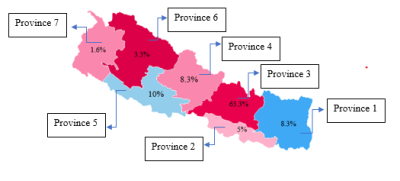 |
Accessibility Of MRI Services At The Top Of The World, Nepal
Babina Aryal1,
Usha Poudel Lamgade2,
Karuna Raya Chhetri3,
Sunita Gwachha4,
and Surendra Maharjan5
1Allied Health Sciences, Brainware University, Kolkata. India, India, 2Radiology, Kist Medical College, Lalitpur, Nepal, 3Radiology, Sharda UNiversity, Sharda University, Delhi, India, India, 4Radiology, Bir Hospital, Kathmandu, Nepal, 5Indiana University Shool of Medicine, USA, IN, United States
Motivation: Due to the geographical landscape,
lack of developmental infrastructure, poor healthcare
system, and expensive health costs, Magnetic Resonance
Imaging (MRI) is not accessible in all parts of Nepal.
Goal(s): Our goal was to evaluate the
accessibility of MRI services in Nepal
Approach: A cross-sectional survey was conducted
to collect the data from different clinical settings.
Results: We demonstrated the non-uniform
distribution of MRI systems across the country. Impact: The results of this study could be used by authorized healthcare legal bodies to improve uniform MRI accessibility across the country. |
| 17:00 |
5167.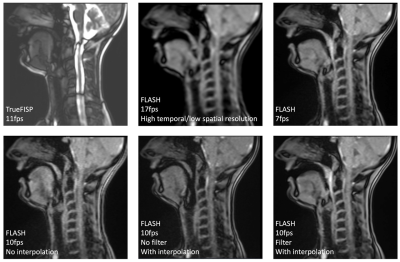 |
Real-time MRI and Audio Synchronization for Vocal Tract
Analysis in Linguistics
Haidee Joy Paterson1,
Ben Lang2,3,
Zainab Hermes4,
Samantha Wray3,5,
Osama Abdullah1,
Alec Marantz3,
and Hadi Zaatiti6
1Core Technology Platform, New York University Abu Dhabi, Abu Dhabi, United Arab Emirates, 2University of California San Diego, San Diego, CA, United States, 3New York University, New York, NY, United States, 4The University of Chicago, Chicago, IL, United States, 5Dartmouth College, Hanover, NH, United States, 6New York University Abu Dhabi, Abu Dhabi, United Arab Emirates Motivation: This study seeks to overcome the challenges associated with characterizing vocal tract articulation during speech. Goal(s): The primary objective of this study is to outline the technical configuration required to optimize real-time MRI with high temporal resolution while synchronizing it with audio recordings. Approach: We employed a single slice FLASH sequence, an MRI-compatible optical microphone, and a signal generator. This setup enables precise synchronization of MRI image acquisition with audio recordings during speech production. Results: Our findings showcase the practicality of our setup in studying Arabic speech articulation, both in letter pronunciation and the articulation of whole words, encompassing various dialects.
Impact: This research highlights the technical
intricacies involved in integrating real-time MRI of the
vocal tract with synchronised speech production,
introducing an innovative application previously
unexplored in linguistic research to address challenging
linguistic problems. |
| 17:00 |
5168.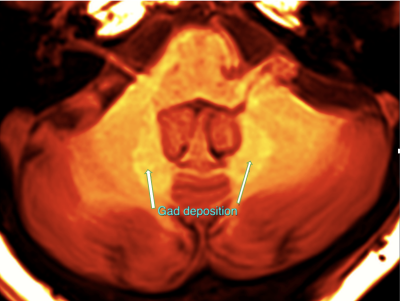 |
The future role of MRI in confirming and monitoring multiple
sclerosis diagnosis without intravenous administration of
GBCAs.
Mariaan Jaftha1,2,
Susan Janse Van Rensburg3,
Merlisa Claudia Kemp4,5,
Frances Robertson6,
Maritha J Kotze7,
Clint Johannes8,
Ronald Van Toorn9,
and Penelope Engel-Hills1
1Faculty of Health and Wellness Sciences, Cape Peninsula University of Technology, Cape Town, South Africa, 2Faculty of Human Biology, University of Cape Town, Cape Town, South Africa, 3Division of Chemical Pathology,Department of Pathology,Faculty of Medicine&Health Sciences, Stellenbosch University, Cape Town, South Africa, 4Department of Medical Imaging & Therapeutic Sciences, Faculty of Health & Wellness Sciences, Cape Peninsula University of Technology, Cape Town, South Africa, 5Medical Imaging, Department of Health and Care Professions, Faculty of health and Life Sciences, University of Exeter, South Cloisters, United Kingdom, 6Department of Human Biology, University of Cape Town, Cape Town, South Africa, 7Division of Chemical Pathology,Department of Pathology,Faculty of Medicine & Health Sciences, Stellenbosch University, Cape Town, South Africa, 8Department of Internal Medicine, Faculty of Medicine & Health Sciences, Stellenbosch University, Cape Town, South Africa, 9Department of Paediatrics & Child Health, Faculty of Medicine & Health Sciences, University of Stellenbosch, Cape Town, South Africa Keywords: Motivation: Multiple sclerosis (MS) is a chronic inflammatory disease affecting the central nervous system (CNS). MS diagnosis needs the objective assessment of white matter (WM) lesions as they disseminate both in space and time. Goal(s): More refined MRI sequences have vastly improved the characterisation of brain volume and focal white matter lesions. Approach: In this study, MRI scans were obtained of 25 adult females diagnosed with relapsing remitting MS and 25 control subjects without MS.
Results: Data collected shows a clear
distinction between the lesion volumes from the two
groups and enhances the validity of MRI and its
potential clinical applicability.
Impact: The high costs and chance of allergic reactions to GBCAs may impose limitations within the patient’s treatment plan. Our study reaffirms the value of MRI without the use of GBCAs and demonstrates its potential for long-term monitoring of MS. |
| 17:00 |
5169.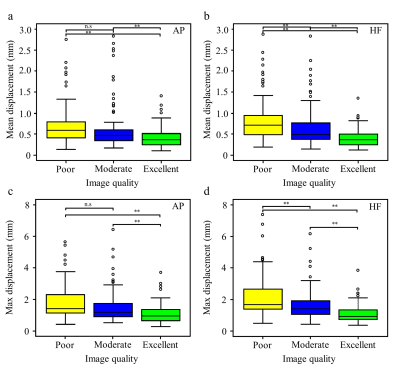 |
Relationship between uterine displacements and quality of
T2-weighted images of the female pelvis
Hironobu Ishikawa1,2,
Kousaku Saotome3,
Hirofumi Sekino4,
Ryo Yamakuni4,
Yuma Takahashi1,
Shinya Seino1,
Masanori Yusa1,
Yoshiyuki Ishimori2,
Masahiko Monma2,
and Hiroshi Ito4
1Fukushima Medical University Hospital, Fukushima, Japan, 2Graduate School of Ibaraki Prefectural University of Health Sciences, Ami, Japan, 3School of Health Sciences, Fukushima Medical University, Fukushima, Japan, 4Fukushima Medical University School of Medicine, Fukushima, Japan Motivation: In some cases, the quality of T2-weighted images is poor independent of the position of the uterus in the pelvis. Goal(s): Our goal was to investigate the relationship between uterine displacement and quality of T2-weighted images. Approach: T2-weighted images of the female pelvis were classified according to image quality. Additionally, uterine displacements were calculated by analyzing cine images of the uterus. Results: The quality of the T2-weighted images of the female pelvis degrades with increasing uterine displacement. Impact: The quality of T2-weighted images is expected to be improved by the analysis of uterine displacements because this would enable us to address the artifacts in advance. |
| 17:00 |
5170.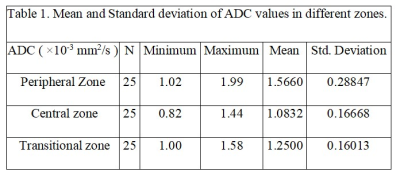 |
MEASUREMENT OF APPARENT DIFFUSION COEFFICIENT IN NORMAL
PROSTATE GLAND
Niroj Sandha1
1Radiology and Imaging, National Academy of Medical Sciences (NAMS), Bhaktapur, Nepal Motivation: The prostate gland consist of 3 distinctive zones, namely Central zone (CZ), Transitional Zone (TZ), and Peripheral Zone (PZ) having diffusive property, which can be measured by apparent diffusion coefficient (ADC) . Goal(s): This study aims to measure ADC values of the prostate with age that varies according to tissue density. Approach: A retrospective cross-sectional study with a purposive sampling technique was conducted on 25 patients with ages ranging from 20-90 years with no history of prostatic disease. Results: Age related decrease in ADC value were observed in this study with significant difference in ADC values between zones of prostate. Impact: when using DWI for diagnosing prostate cancer, age-related changes in ADC value need to be considered. Increase in age have influence in ADC value of different zones showing significant differences, with highest in PZ and lowest in CZ. |
| 17:00 |
5171.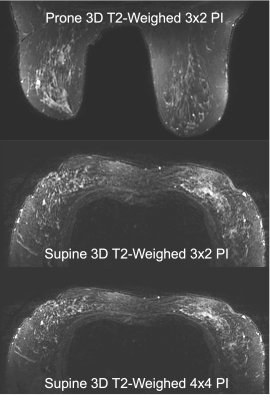 |
3D T2-Weighted Imaging of the Breasts in the Supine Position
Karla Raylene Epperson1,
Jana Vincent2,
Bruce Daniel 1,
Fraser Robb2,
Patricia Lan3,
Arnaud Guidon4,
Brian Hargreaves 1,
and Catherine J Moran1
1Radiology, Stanford University, Stanford, CA, United States, 2Coils, GE HealthCare, Aurora, OH, United States, 3MRI Clinical Solutions and Research Collaboratins, GE HealthCare, Menlo Park, CA, United States, 4Global MR Applications and Workflow, GE HealthCare, Boston, MA, United States Keywords: Motivation: Despite its importance in breast MRI, T2-weighted supine imaging is understudied, risking image quality due to motion and prolonged respiratory-triggered scans. Goal(s): To evaluate effectiveness of 3D supine T2-weighted breast imaging using a 60-channel flexible breast coil. Approach: Three individuals underwent prone and supine breast imaging using two parallel imaging settings. An MRI Radiologist evaluated four images in a blinded study of techniques. Results: Increased acceleration available with the 60-channel breast coil, achieved high 3D T2-weighted image quality in the supine position within a clinically feasible scan time. Impact: Supine positioning in breast MRI, facilitated with flexible blanket coils and fast, high-performing protocols, has the potential to improve the comfort and efficiency of the exam, allowing breast MRI to be accessible to a much wider population of women. |
| 17:00 |
5172.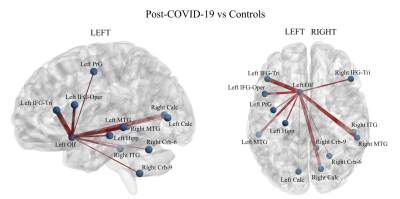 |
Altered Functional Connectivity of the Olfactory Cortex in
Post-COVID-19 Brain Network
Ruoxi Lu1,2,
Gianpaolo Del Mauro2,
Yan Guo1,
Xinyu Liang1,
Jianyu Li1,
Yanting Zheng3,
Yiran Li2,
Yujie Liu3,
Ze Wang2,
and Shijun Qiu3
1First clinical Medical College, Guangzhou University of Chinese Medicine, Guangzhou, China, 2Department of Diagnostic Radiology & Nuclear Medicine, University of Maryland,Baltimore, Baltiomore, MD, United States, 3The Department of Radiology, The first Affiliated Hospital of Guangzhou University of Chinese Medicine, Guangzhou, China Keywords:
Motivation: To investigate the persistent effects
on the brain following recovery from COVID-19.
Goal(s): To examine differences in brain’s
functional connectivity between post-COVID-19 subjects
and healthy controls.
Approach: To use resting-state fMRI data to
identify brain functional networks.
Results: Post-COVID subjects exhibited higher
functional connectivity in a brain network including the
left olfactory cortex as the main hub connected to other
brain regions. Impact: We observed that post-COVID-19 subjects continue to exhibit significant anomalies in the olfactory cortex of the brain. These results support previous findings and highlight the relevance of research from a fMRI perspective for investigating the effects on brain of COVID-19. |
| 17:00 |
5173.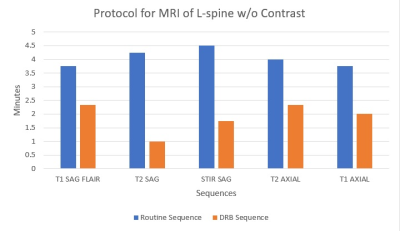 |
From Neural Networks to Neuroimaging: Evaluation of Deep
Learning-Based MRI Reconstruction to Accelerate, Enhance and
Improve Patient Outcomes
Marc DiCamillo1,
Shawn Lyo2,
Bridget Pomponio1,
George Englehardt3,
Sanjeev Chawla2,
Lisa Desiderio2,
and Suyash Mohan2
1MRI, Hospital of the University of Pennsylvania, Philadelphia, PA, United States, 2Perelman School of Medicine at the University of Pennsylvania, Philadelphia, PA, United States, 3MRI, Children's Hospital of Pennsylvania, Philadelphia, PA, United States Keywords: Motivation: The duration of MRI examinations can prove taxing for patients, leading to incomplete studies and compromised image quality due to motion. Critically ill patients requiring monitoring, those with MRI scanning time restricted implanted devices, and patients with altered mental status may be affected by lengthy scans. Goal(s): We aim to reduce scan times in neuroradiologic studies while maintaining or improving image quality. Approach: We applied accelerated acquisition and deep learning-based reconstruction to our current protocols. The images were assessed for signal-to-noise ratio and quality by two neuroradiologists. Results: Scan times were drastically reduced, some more than twofold, with simultaneous improvement of image quality. Impact: Deep learning-based reconstruction not only reduces MRI scanning time in common neuroradiologic examinations, but it also improves overall image quality. This empowers clinical sites to manage a higher workload while also diminishing potential for patient safety incidents. |
| 17:00 |
5174.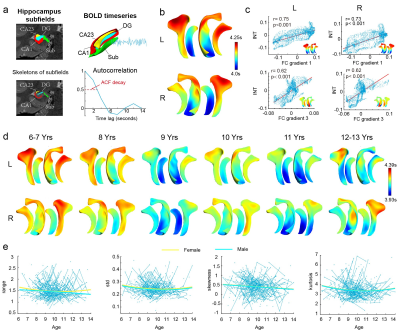 |
Development in Intrinsic Neural Timescale of Hippocampal
Subfields during Childhood and Adolescence
Debin Zeng1,
Qiongling Li2,
Yirong He2,
Xiaoxi Dong2,
Shaoxian Li2,
Shenghan Bi2,
and Shuyu Li2
1Beijing Advanced Innovation Center for Biomedical Engineering, School of Biological Science & Medical Engineering, Beihang University, Beijing, China, 2State Key Laboratory of Cognitive Neuroscience and Learning, Beijing Normal University, Beijing, China Keywords: Motivation: The hippocampus plays a pivotal role in cognition, hosting an intrinsic neural timescale hierarchy. Goal(s): How does this intrinsic neural timescale hierarchy within the hippocampal subfield evolve throughout childhood and adolescence? Approach: Our study encompasses 300 healthy children (6-14 years). We characterized the intrinsic neural timescale by assessing the decay of the temporal autocorrelation function (ACF) and utilized mixed-effect model to chart the developmental trajectories. Results: Group-level intrinsic timescales within hippocampal subfields show clear temporal hierarchies along the long-axis and medial-lateral axis, and show significant correlations with hippocampal functional connectome gradients. Developmental trajectories reveal significant maturation and reorganization during childhood and adolescence. Impact: Our research findings offer valuable insights into the unique patterns of INT within various hippocampal subfields. Furthermore, they shed light on the significant maturation and reorganization of the temporal integration and segregation structure that occurs during the onset of puberty. |
| 17:00 |
5175.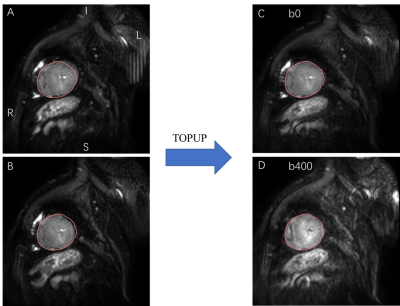 |
EPI Distortion Correction using FSL TOPUP for Diffusion
Tensor Imaging of the Human Heart
Gang Yin1,
Peng Sun2,
Zhigang Wu2,
Zhixiang Dong1,
Leyi Zhu1,
Weipeng Yan1,
Lele Liu1,
Xiaoxiao Zhang2,
Liangjie Lin2,
Jiazheng Wang2,
Shihua Zhao1,
and Minjie Lu1
1Fuwai Hospital, Beijing, China, 2Philips Healthcare, Beijing, China Motivation: Cardiac diffusion tensor imaging (cDTI) enables the characterization of the myocardial microstructural environment. However, B0 inhomogeneity around the heart can lead to EPI distortion and signal loss in cDTI. Goal(s): To investigate the feasibility of using FSL TOPUP for EPI Distortion Correction in cDTI. Approach: This proposed approach could be seamlessly integrated into cDTI postprocessing, significantly improving the accuracy and reproducibility of cDTI, particularly when researchers are analyzing metrics alongside other cardiac image parameters. Results: The FSL TOPUP method could correct EPI distortion in both diffusion-weighted images (b0 and b400), following which kinds of cDTI metrics are reconstructed successfully after the correction. Impact: The FSL TOPUP algorithm has been successfully integrated into the cDTI postprocessing in order to correct EPI distortion effectively. |
| 17:00 | 5176. |
White Matter Abnormalities in Multiple Sclerosis: A
Network-Meta-Analysis of Diffusion Kurtosis Imaging Studies
Abdulmajeed Alotaibi1
1King Saud University for Health Sciences, Riyadh, Saudi Arabia Motivation: We want to confirm MK's ability in MS by a meta-analysis because different research have reported contradicting outcomes of MK value (that can indicate axon and myelin microstructural complexity). Goal(s): To compare DKI in WMLs and NAWM Approach: Tabular pairwise comparison estimates for each category. Mean ranks, 95% confidence intervals, and cumulative ranking curve were shown. Results: 3 studies evaluated MK in NAWM and WM among MS patients; 4 compared MK in WM among control and MS patients; and 5 compared MK in WM and NAWM as well. Impact: The study found that MS WMLs and NAWM have lower MKs. The findings may help physicians evaluate MS WMLs using MK consistency. |
| 17:00 | 5177. |
Choroid plexus enlargement is associated with
neuroinflammation and reduction of blood brain barrier
permeability in depression
Noha Althubaity1
1King Saud University for Health Sciences, Riyadh, Saudi Arabia Motivation: We are motivated to investigate CP volume alterations in depression and their associations with brain inflammation Goal(s): To investigate CP volume alterations in depression and associations with central brain inflammation Approach: The study re-analyzed 51 depressed participants (HDRS score >13) from the Wellcome Trust NIMA project. Fully peripheral cytokine profiling [11C] PK11195 PET/structural MRI imaging measured neuroinflammation, blood-to-CSF radiotracer exchange parameters, and CP volume Results: Depressed patients had a higher CP volume than HCs (t(76) =+2.17, p=0.03), which was positively linked with [11C]PK11195 binding in the anterior cingulate, prefrontal, and insular cortex. CP volume negatively correlated with blood-to-CSF radiotracer exchange parameters (r=-0.28, p=0.02) Impact: Findings suggest that brain barrier alterations may reduce blood-CSF exchanges, disrupting brain homeostasis and causing depression-related inflammation |
| 17:00 | 5178. |
Quantifying bone marrow fat changes with in vivo proton
magnetic resonance spectroscopy: impact of nuts and physical
activity
Moreno Zanardo1,
Anna Colarieti1,
Paolo Vitali1,
Giovanni Di Leo1,
Anna Ferrulli2,
Stefano Massarini2,
Livio Luzi3,
and Francesco Sardanelli3
1IRCCS Policlinico San Donato, Milan, Italy, 2IRCCS MultiMedica, Milan, Italy, 3Università degli Studi di Milano, Milan, Italy Motivation: This research is driven by the pivotal role of 1H-MRS in comprehending the relationship between bone marrow fat (BMF), metabolic conditions, and lifestyle interventions. Goal(s): This research holds the potential to uncover 1H-MRS as a tool for comprehending metabolic health through lifestyle interventions.
Approach: It seeks to elucidate the therapeutic
potential of lifestyle interventions in regulating BMF
and its implications for metabolic health. Results: The research observed a non-significant trend towards reduced BMF following the intervention. Impact: The study's results underscore the potential of 1H-MRS in assessing BMF in the context of lifestyle interventions. These findings stimulate further investigations, encouraging scientists and clinicians to explore larger cohorts to elucidate the role of BMF in metabolic health. |
| 17:00 |
5179. |
Block-Wise Neural Network for Brain Tumor Identification in
Magnetic Resonance Images
Fawaz Alqahtani1 and
Abdullah A. Asiri1
1Najran University, Najran, Saudi Arabia
Motivation: medical support for treating tumor
patients Goal(s): critical necessity for more accurate computeraided methods for early tumor detection Approach: proposing a finetuned Block-Wise Visual Geometry Group19 (BW-VGG19) architecture Results: We achieved an accuracy of 0.98% Impact: the best results associated with the existing methods |
| 17:00 |
5180.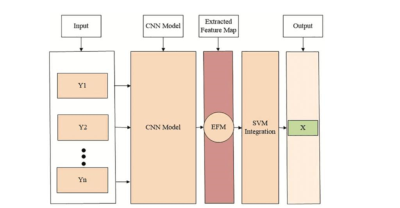 |
A Novel Inherited Modeling Structure of Automatic Brain
Tumor Segmentation from MRI
Fawaz F Alqahtani1 and
Abdullah A. Asiri1
1Najran University, Najran, Saudi Arabia Motivation: Auto segmentation of the affected part is needed to facilitate radiologists Goal(s): we have considered a hybrid model that inherits the convolutional neural network (CNN) properties to the support vector machine (SVM) for the auto-segmented brain tumor region Approach: we have considered a hybrid model that inherits the CNN properties to the SVM for the auto-segmented brain tumor region Results: An accuracy value of 0.98, which is most prominent than existing techniques Impact: The proposed approach is more suitable for medical experts to diagnose the early stages of the brain tumor. |
The International Society for Magnetic Resonance in Medicine is accredited by the Accreditation Council for Continuing Medical Education to provide continuing medical education for physicians.